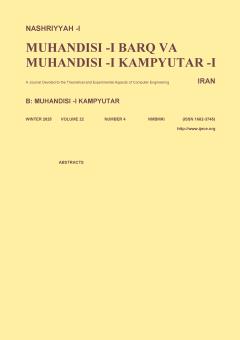Improving Delay and Energy Consumption in Task Offloading for Fog-Based IoT Networks Using Software-Defined Networks
Subject Areas : electrical and computer engineeringreza khaleghi far 1 , Reza mohammadi 2 * , Mohammad Nassiri 3 , Sakine sohrabi 4
1 - Faculty of Computer Engineering, bu-ali sinaThamedanT iran
2 - Faculty of Computer Engineering, bu-ali sina, hamedan , iran
3 - Faculty of Computer Engineering, Bu-Ali Sina University, Hamedan, Iran
4 - Faculty of Computer Engineering, Bu-ali Sina, Hamedan, Iran
Keywords: Internet of Things (IoT), Firefly Optimization Algorithm, Fog Computing, Software-Defined Networks (SDN).,
Abstract :
The rapid growth of IoT technology has led to the emergence of various latency-sensitive IoT applications. These applications require significant computational resources for real-time processing, resulting in high energy consumption in IoT devices. To address this issue, task offloading using fog computing has emerged as a novel solution. Fog-based task offloading reduces latency and enhances the flexibility of IoT devices. This study proposes a mathematical model aimed at minimizing end-to-end delay and energy consumption for task offloading in IoT-fog networks based on software-defined networking (SDN) infrastructure. The simulation results of the proposed model are compared with two metaheuristic algorithms (Genetic Algorithm and Firefly Algorithm) and a baseline paper, focusing on delay and energy consumption metrics. After implementing the scenario and conducting analysis, the simulation results indicate that the proposed model, using metaheuristic algorithms, achieved approximate average reductions of 18% in delay and 19% in energy consumption.
[1] Z. Jalali Khalil Abadi, N. Mansouri, and M. Khalouie, "Task scheduling in fog environment-challenges, tools & methodologies: a review," Computer Science Review, vol. 48, Article ID: 100550, May 2023.
[2] R. K. Naha, et al., "Fog computing: survey of trends, architectures, requirements, and research directions," IEEE Access, vol. 6, pp. 47980-48009, 2018.
[3] H. Alhussian, N. Zakaria, and A. Patel, "An unfair semi-greedy real-time multiprocessor scheduling algorithm," Computers & Electrical Engineering, vol. 50, pp. 143-165, Feb. 2016.
[4] R. Thakur, G. Sikka, U. Bansal, J. Giri, and S. Mallik, "Deadline-aware and energy efficient IoT task scheduling using fuzzy logic in fog computing," Multimedia Tools and Applications, vol. 2024, 2024.
[5] M. S. U. Islam, A. Kumar, and Y. C. Hu, "Context-aware scheduling in fog computing: a survey, taxonomy, challenges and future directions," J. of Network and Computer Applications, vol. 180, Article ID: 103008, Apr. 2021.
[6] A. Raglin, S. Metu, S. Russell, and P. Budulas, "Implementing internet of things in a military command and control environment," in Proc. of SPIE, the Inte. Society for Optical Engineering, Article ID: 1020708, Anaheim, CA, USA, 9-13 Apr 2017.
[7] Maniah, B. Soewito, F. Lumban Gaol, and E. Abdurachman, "A systematic literature review: risk analysis in cloud migration," J. of King Saud University-Computer and Information Sciences, vol. 34, no. 6, pt. B, pp. 3111-3120, Jun. 2021.
[8] P. Schulz, et al., "Latency critical IoT applications in 5G: perspective on the design of radio interface and network architecture," IEEE Communications Magazine, vol. 55, no. 2, pp. 70-78, Feb. 2017.
[9] P. Mach and Z. Becvar, "Mobile edge computing: a survey on architecture and computation offloading," IEEE Communications Surveys & Tutorials, vol. 19, no. 3, pp. 1628-1656, Thirdquarter 2017.
[10] K. Dolui and S. K. Datta, "Comparison of edge computing implementations: fog computing, cloudlet and mobile edge computing," Global Internet of Things Summit, 6 pp., Geneva, Switzerland, 6-9 Jun. 2017.
[11] C. M. Huang, et al., "V2V data offloading for cellular network based on the software defined network (SDN) inside mobile edge computing (MEC) architecture," IEEE Access, vol. 6, pp. 17741-17755, 2018.
[12] D. Dey, S. Chandra, and N. Ghosh, "HessianAuth: an ECC-based distributed and efficient authentication mechanism for 6LoWPAN networked IoT devices," in Proc. of the 24th Int. Conf. on Distributed Computing and Networking, pp. 227-236, Kharagpur, India, 4-7 Jan. 2023.
[13] K. Sood, S. Yu, and Y. Xiang, "Software-defined wireless networking opportunities and challenges for internet-of-things: a review," IEEE Internet of Things J., vol. 3, no. 4, pp. 453-463, Aug. 2016.
[14] F. M. Talaat, H. A. Ali, M. S. Saraya, and A. I. Saleh, "Effective scheduling algorithm for load balancing in fog environment using CNN and MPSO," Knowledge and Information Systems, vol. 64, pp. 773-797, 2022.
[15] A. Najafizadeh, A. Salajegheh, A. M. Rahmani, and A. Sahafi, "Multi-objective task scheduling in cloud-fog computing using goal programming approach," Cluster Computing, vol. 25, no. 1, pp. 141- 165, Feb. 2022.
[16] L. Mas Manchón, J. Vilaplana, J. Mateo, and F. Solsona, "A queuing theory model for fog computing," The J. of Supercomputing, vol. 78, no. 8, pp. 11138-11155, Feb. 2022.
[17] I. Z. Yakubu, L. Muhammed, Z. A. Musa, Z. I. Matinja, and I. M. Adamu, "A multi agent based dynamic resource allocation in fog-cloud computing environment," Trends in Sciences, vol. 18, no. 22, Article ID: 413, 15 Nov. 2021.
[18] S. Misra and N. Saha, "Detour: dynamic task offloading in software-defined fog for IoT applications," IEEE J. on Selected Areas in Communications, vol. 37, no. 5, pp. 1159-1166, May 2019.
[19] M. Abbasi, E. Mohammadi Pasand, and M. R. Khosravi, "Workload allocation in IoT-fog-cloud architecture using a multi-objective genetic algorithm," J. of Grid Computing, vol. 18, no. 1, pp. 43-56, Jan. 2020.
[20] K. Alwasel, et al., "IoTSim-Osmosis: a framework for modeling and simulating IoT applications over an edge-cloud continuum," J. of Systems Architecture, vol. 116, Article ID: 101956, Jun. 2021.

